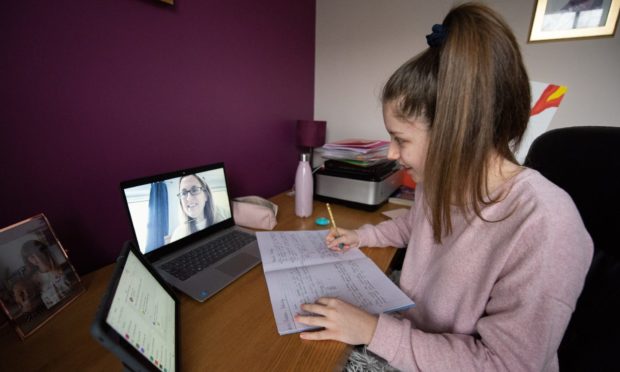The Scottish education system has been criticised by a parents’ body for a perceived failure to support pupils during the pandemic.
Connect, previously known as the Scottish Parent Teacher Council, has published its survey report ‘Lockdown 2021: How are you doing?’
It said that in future, schools and nurseries must be kept open, and only closed as an “absolute last resort”.
It also found that some children are not ‘ready’ for the transition back to normality.
The findings, based on the responses of 784 parents and carers across 31 local authorities, led the body to declare that “lessons of school closures must be learned.”
The survey looked at the second lockdown, and covered the period when schools and nurseries began reopening.
Almost half (48%) of respondents said their child’s school or nursery wasn’t getting in touch or checking in regularly with the family.
Over half (53%) said their children required more health and wellbeing support.
Families under ‘extreme pressure’
The report said that children in need of extra support, or who were unable to learn at home, should have been provided with a school or nursery place.
It said: “This group of children and their families have been hit incredibly hard by Covid restrictions – and specialist support is still not available.”
Many families with children with additional support needs (ASN) said not enough help was given with school work.
Twenty percent of respondents said their child had ASN – 69% of children with ASN were not in school or nursery during lockdown, despite ASN being included in the definition of ‘vulnerable’ children who were entitled to a school place.
Single parent households – 13% of respondents – also struggled, and were found more likely not to have what they needed for sufficient schooling.
The report acknowledged the “extreme pressure” families have been under during the pandemic.
Across the board, issues and concerns included: not enough school work; too much school work; no social opportunities for young people; too much family stress and pressure; and negative impact of home schooling on the relationship between parent and child.
‘It nearly broke my husband’
One mother said: “If it wasn’t for Granny’s willingness to help us when I am at work as a doctor, my children would not have been able to do home learning or be adequately looked after.
“We struggled alone with this during the first lockdown and it nearly broke my husband and the children.
“Thank goodness essential childcare rules were relaxed this time round and we live close to grandparents.
“Many will not.”
Another said simply: “When will this nightmare end?
“Kids need to be back in school full time.
“Parents aren’t teachers.”
Some parents’ comments described children not feeling ready for their next steps, something which the report said “must be addressed to avert more mental health issues.”
Children and young people being able to move on to their next steps positively and confidently was parents’ top priority for education recovery.
“Transitions are crucial,” said Connect.
Lockdown learning experiences varied significantly from school to school and class to class.
Communication from school to home, and the learning on offer, was “more organized” during the second lockdown than the first.
However, parents and children were not consulted often enough for further improvements to be made.
Inequalities that already existed in society and in education were exposed, highlighting the need to address these “with unflinching commitment.”
£300 million in education recovery
A Scottish Government spokeswoman said: “Although we recognise that remote learning was tough on pupils and parents, reports from Her Majesty’s Inspectors of Education between January and April 2021 showed that the delivery of remote learning improved greatly between the first and second lockdowns.
“The needs of vulnerable pupils, including those with additional support needs, have been prioritised as part of our response to the pandemic.
“We have committed to investing over £300 million in education recovery over 2020-21 and 2021-22, and the wellbeing of our learners continues to be at the forefront of our plans.”
